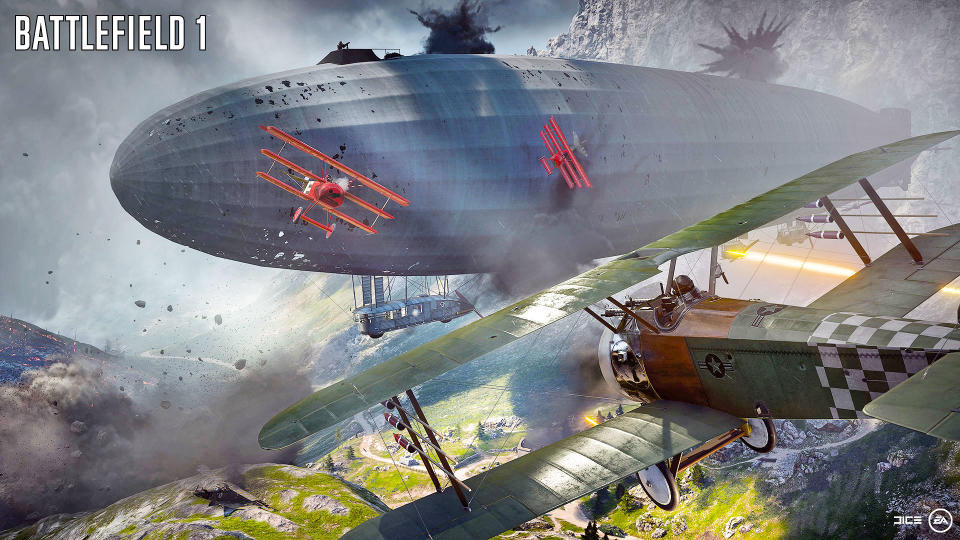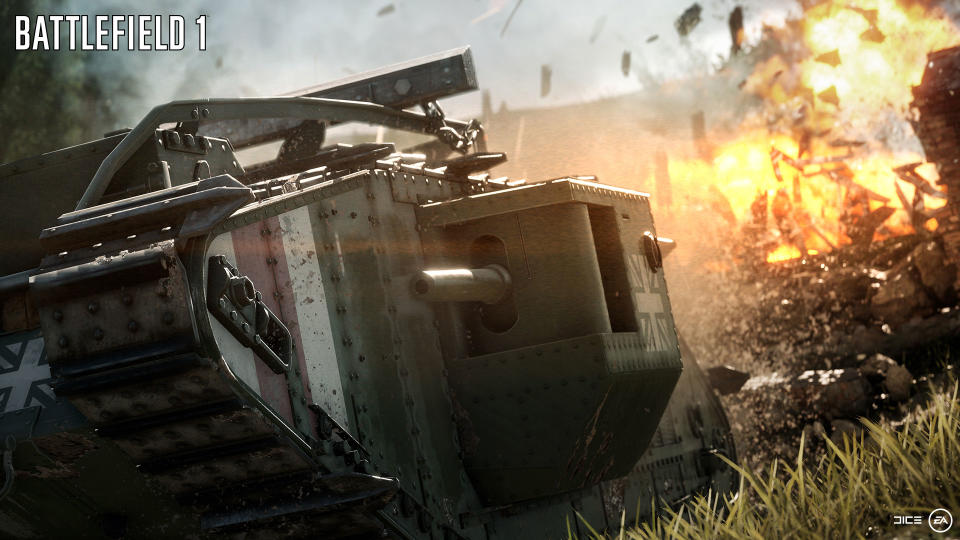'Battlefield 1' learned a lot from 'Star Wars: Battlefront'
The galaxy far, far away inspired developer DICE’s version of World War I.

When Electronic Arts and DICE released Star Wars: Battlefront last fall, fans complained that it was far too simple, a shell of a game. The reaction was justified, but as shallow as the game was, it wasn't without merit. A lot of what Battlefront got right (a massive sense of scale, easier to control aircraft and monstrous mechanical instruments of war) has made its way into Battlefield 1.
The latter series has always prided itself on being a thinking-person's shooter. But recent releases have become bloated, with a diminished focus on what made the franchise great in the first place. In particular, these recent installments have tended to emphasize spectacle over strategic gunfights, with each player serving a distinct role in combat. Some of Battlefront's simplicity made its way into DICE's version of World War I, but based on what I played at E3, that isn't a detriment -- it's an asset.
Battlefront and Battlefield 1 were developed in parallel, so it's no surprise there was some cross-pollination. The overlap was sometimes unexpected, though. The Battlefield series has always had aircraft of some sort, but simply getting in the pilot's seat didn't ensure success; being a proficient (and genuinely helpful) helicopter or fighter jet pilot takes a lot of practice. Battlefront took an arcade-y approach to controlling the sci-fi universe's iconic spacecraft and made each ship easy to pick up and have fun with.
"There's been a lot of crossover between how [we] think about air combat between Star Wars and Battlefield 1," DICE General Manager Patrick Bach said. "That doesn't mean it's the same. It's actually far from it."
Bach is right. Battlefield's biplanes aren't just X-Wings with machine guns bolted on. They're fragile, heavy-feeling and susceptible to small-arms fire from the ground. Most noticeably, they're an awful lot slower to maneuver. "There's much more of a physical presence to the biplanes," Bach said. They're a little easier to fly than before, sure, but I still crashed more times than I care to admit.

One of the unique aspects of Battlefront was the presence of lumbering AT-AT Walkers from The Empire Strikes Back's assault on Hoth. Bach said even though they're quite different, Battlefield 1's tanks are the equivalent of Walkers. "They have a lot of stopping power and you probably behave the same way when you see a tank as you would when you see an AT-AT -- you fight or you run; there's no other option," he said.
That doesn't mean you're helpless should you find yourself facing down one. Bach noted that foot- soldiers have more options to take them out this time around. "I compare it to meeting a dragon [in other games] and feeling like you can actually take it down, but it will be a struggle," he said. "It's almost like meeting a miniboss on the battlefield."
Then there are the zeppelin warships. The difference between these and the Walkers is that they're actually player-controlled and you can direct where they float above the chaos below -- a departure from the autonomous AT-ATs. When a zeppelin arrives, it can dominate the area it's floating above with massive firepower from player-occupied turrets. This is especially helpful when you're playing Conquest and are defending control points from above. If you're feeling gutsy, you could even exit the upper turrets and use a rifle to take potshots, on foot, from the top of the blimps. Based on my experience, however, I don't recommend that. At all.
That's because in a turret I had a bit of protection and a lot of firepower. That wasn't the case when I was aiming down the sights of my gun.
Like the other aircraft -- and unlike the Walkers -- these blimps are particularly fragile. One teammate making a couple of passes with biplane guns combined with anti-aircraft fire from the ground makes short work of them. When the opposing team knocks one out of the sky, it erupts in a ball of fire, and the wreckage will destroy whatever (unfortunately) is below it at the time. Seeing it happen is as satisfying as tripping the Empire's most fearsome ground unit and watching it fall on its "face."
I haven't loved a Battlefield game since 2010's Bad Company 2. But during a single round of Conquest set on a map in northern France, I caught a glimpse of the game that had me smitten five years ago. I've been chasing that figurative dragon with each successive sequel since and come away disappointed. From the admittedly small portion I played, Battlefront's influences haven't hurt Battlefield 1; they've helped bring the series back to its roots.
The revamped class system distills each to its core duties, and the medic (my personal favorite) finally feels like a full-on support role again. It isn't a combat medic with an assault rifle, similar to what Battlefield 4 did to the class in 2013; it's just a medic. I tried rushing in and taking out enemies with a single-shot rifle and was mowed down time and time again, not helping my team at all. Once I remembered that the way to play was reviving downed teammates and dropping health kits during firefights, I was much more effective and having a lot more fun. It's something I haven't felt about the series in years.
I can't help but feel that Battlefront helped DICE strip back some of the bloat that has crept into Battlefield during the past few games. But for all the influences, Battlefield still feels like Battlefield. If you were worried about it being last year's hollow LucasArts game with a World War I skin slapped on, don't be.
Follow all the news from E3 2016 here!

